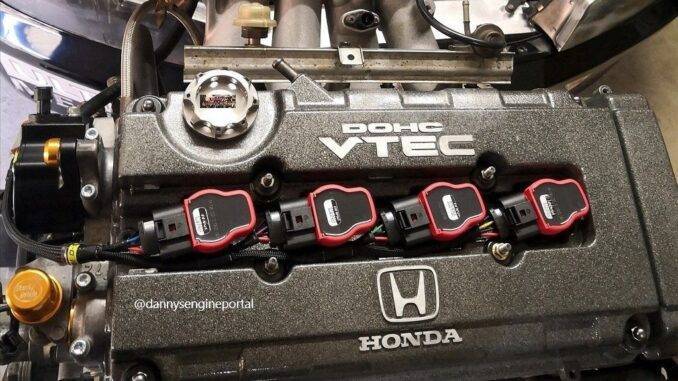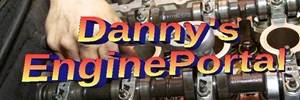
The most sophisticated, of all ignition systems. The coil on plug ignition system (COP), places an ignition coil, directly on the top of each spark plug.
As a result, (COP) ignition eliminates the need for distributors, and spark plug wires.
With the (COP) ignition system, ignition timing, is handled by the (PCM), based on inputs from various sensors.
The coil on plug ignition system (COP), uses redesigned ignition coils, capable of creating higher voltages.
And, with no moving parts there are, lower maintenance costs, and repairs are less frequent.
What Is A Coil On Plug Ignition System (COP)
So, with the coil on plug ignition system (COP), each spark plug is ignited, by its own coil. That means, the (PCM), can control the spark and spark timing, on an individual per-cylinder basis. That gives better control over, spark timing for more horsepower, better mileage and fewer emissions.
The (COP) ignition, is a zero-moving parts assembly that replaces the:
- Mechanically rotating distributor shaft.
- Distributor cap.
- Distributor rotor.
- Spark plug wires.
Spark plug wires, have always been the weak link, in the whole ignition process. As a result, eliminating the plug wires improves, long term reliability. Also, by placing the coil, as close as possible to the plug, the (COP) ignition also reduces energy losses.
Using multiple coils instead of one coil means, each of the coils have more time, to energize between firings. This increased coil saturation time, increases the available voltage from the coil. This increased time, helps the most at higher rpms, where misfires are more likely to occur.
The coil on plug ignition system (COP), delivers about 30 percent more spark energy. Compared to, the old distributor, single coil and spark plug wires system.
Three Or Four Wire Systems
A coil with three wires has:
- One for power.
- One for ground.
- Also, one that carries the command signal, from the (PCM), that operates the coil’s, internal switching transistor.
If there’s a fourth wire, that one sends a firing confirmation signal, to the (PCM).
What Can Cause, A Coil On Plug Ignition System (COP) To Fail
Above all, heat is the most common reason, for a coil on plug ignition system (COP) to fail. This can be either, extremely high heat over a prolonged period of time. Or, just thousands of normal heat cycles. Heat, either extreme or over time, can crack the rubber coil casing and allow, moisture to enter the coil.
Other reasons could be, the internal primary windings of the coil, failing to open. As a result, of the extremely high voltage flow. The windings could also, become so corroded, that the electrical resistance becomes too high. The spring inside the boot over the spark plug could also, become corroded enough, to cause a poor connection.
The pins on the wiring harness plug-in connector, could also, become corroded or broken. The coils in a, coil on plug ignition system (COP), can be damaged by degreasers and water during engine cleaning.
Common causes are, worn spark plugs, excessively lean “air fuel” mixture and liquid getting into the spark plug tubes.
So, What Are The, Failure, Warning Signs
A failing coil will cause a wide variety of, starting and driveability problems. Failures can cause hard starting, refusal to start, extremely poor gas mileage. And, a possible stalled engine while driving. Importantly, the misfiring coil, may not trigger a (MIL) to notify the driver. However, the misfire, will always cause a (DTC) to be set and stored.
Apart from the (MIL), the most common drivability issue is, a slight jerk, jolt, shutter or hesitation, on acceleration. The hesitation or shudder, does not have to come during heavy acceleration. The failing coil will probably misfire, anytime the engine (rpms) increase, after a period of steady engine speed.
A misfire can occur from a:
- Slight increase in engine speed.
- Subtle downshift caused by the cruise control, merely to maintain speed going up a slight incline.
The opposite is, also true. A failing coil may cause the engine to backfire, (loud pop from the engine) during, sudden acceleration.
Engine Misfires, Are A Common Problem
(COP) ignition problems, can include many of the same issues, as other ignition systems. And, my include such things as, misfiring, hard starting or a no start.
Also, spark plugs, can still be fouled by:
- Oil.
- Fuel deposits.
- Pre-ignition.
- Detonation.
So, coil on plug ignition systems (COP), are not immune to trouble.
A weak, corroded, open circuit or otherwise bad coil, will cause a misfire. The (PCM) will send the signal for the coil to energize and discharge, causing the spark to fire. But, the plug does not fire.
A misfire, causes unburned fuel, to enter the exhaust system. This increases the temperature of, the catalytic converter, which could damage it. To prevent this, the (PCM) generally, shuts off the fuel injector on a misfiring cylinder.
In general, an excessive misfire rate is between, 20 and 50 misfires, per 1000 crankshaft revolutions. A (DTC) is set, when this misfire threshold is hit. As a result, a (MIL) is common.
Diagnostic Trouble Codes
The process is pretty simple, as driveability problems go. The (PCM) controls the spark to each cylinder. This is based on inputs from, the (CMP) and the (CKP) sensors. The controllers keep track of every single misfire. Engine misfires, do seem to be common in, coil on plug ignition systems (COP).
In general, There are two types of misfires:
- Misfire, per cylinder.
- Random or multiple, misfires.
A random or multiple misfire is when, more than one cylinder misfires, at almost the same time.
The (DTC) code, P0300 is a random misfire. As all techs know, this can be caused by dozens of things. This code does not mean, many coils have failed at the same time.
But, Instead, P0300 usually means, situations like:
- Intake vacuum leak, from gaskets or hoses.
- Low fuel pressure or a bad fuel pressure regulator.
- Loose or corroded, coil connectors.
- Dirty, fuel injectors.
- Worn or oil-fouled, spark plugs.
- Bad fuel.
- Defective crank position sensor.
- Failing driver circuit, in the (PCM).
As a general, random, multiple misfire code, P0300 is probably, a fuel delivery problem or a vacuum leak. It is probably not spark-ignition related. In fact, P0300 usually rules out a bad coil.
On the other hand, (DTC) codes like, P0301, P0302, etc. indicate, a misfire in a particular cylinder. P0304, for example, means a misfire, in cylinder #4. Importantly, if the misfire is due to a weak or bad coil, you should also, find a coil (DTC). For example, P0354 means a misfiring coil in cylinder #4.
Conclusion
So, if you have to replace the coil for one cylinder, replace them all. The coil on plug ignition system (COP) track record, is crystal clear. So, if one coil fails, the others, are not far behind.
BY DANNY BENDER




